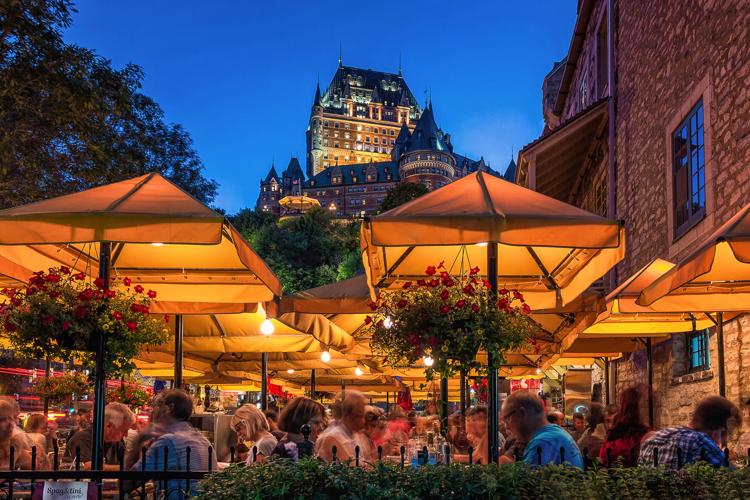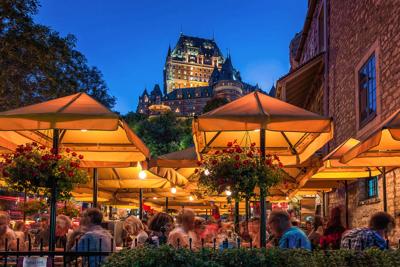It is still possible in some spots in �ϳ�é���� City to stand in a place that hasn’t changed in hundreds of years. It is part of the charm of this gem of New France, founded in 1608 on the north shore of the St. Lawrence River. A trip to this part of the province allows you to not only see history, but also touch and immerse yourself in a bygone era. And this ability extends well beyond the walls of its old city to the communities surrounding the provincial capital.
DAY ONE
In the morning: Start by exploring some of the historic places that make �ϳ�é���� City a UNESCO World Heritage Site. Stroll across the Plains of Abraham — the site of a 1759 battle between the French and British — before heading beneath Dufferin Terrace to see some of the impressive remains of Château Saint-Louis, the home of �ϳ�é����’s governors from 1620 to 1834.

The Hôtel-Musée Premières Nations in Wendake.
Jean-François HamelinYour historic tour should also include visits to the oldest house in the city Maison Jacquet — which dates to the 1670s — the Cathedral of the Holy Trinity and Notre Dame de �ϳ�é���� Basilica, and the Citadelle of �ϳ�é����, the star-shaped fortifications built between 1820 to 1850 that now houses a museum full of artifacts including medals and uniforms.
In the afternoon: Located on the edge of the old city, Le Monastère des Augustines is easy to access by car for those hesitant about driving through the city’s narrow roadways.

The Fairmont Le Château Frontenac is one of the most photographed buildings in �ϳ�é����.
Bonjour QuebecA former convent started by the Augustinian sisters in the 1600s, the building is now a wellness hotel with accommodations in the former cloister. It includes spartan single and double occupancy rooms in the former cells (small sleeping rooms) used by the nuns, which have access to shared bathroom facilities, and contemporary rooms with ensuites. None of the rooms have televisions.
In the evening: Once checked in, take a moment to orientate yourself be exploring the cobbled streets of the old �ϳ�é���� City and enjoy dinner at the iconic Fairmont Le Château Frontenac, one of the most photographed buildings in the province. The hotel is home to Bistro le Sam, where you can enjoy cod fish and chips or flat iron steak, and the Champlain Restaurant. It serves modern regional cuisine, with dishes that include arctic char served with a burnt maple vinaigrette and duck served with a slated plum jus.
DAY TWO
In the morning: In keeping with the history of the convent, the continental-style breakfast served at des Augustines is a silent affair, allowing the opportunity for contemplation. After eating, be sure to visit the onsite museum, which chronicles the story of the Augustinian sisters and how they offered the first form of healthcare in New France. The cloister is part of the larger Hôtel-Dieu, which was the first hospital established north of Mexico City in the Americas, and also houses the skull of St. Jean de Brébeuf, a Jesuit missionary in New France who was canonized in 1930.

History is around every corner in �ϳ�é���� City.
Benoit CecileThe main entrance to its museum includes a “baby hatch” dating from the early 1800s. Over the years, an estimated 1,400 orphaned babies were left in the door, which rotates once closed. Many of the children died, while others were adopted or reunited with their families.
In the afternoon: Head to the lower section of the old city for lunch at Le Don, �ϳ�é���� City’s first fully vegan restaurant. Its menu includes delicious items that include beet tartare, mushroom fettuccine, bibimbap and burrito bowls.
From the restaurant it is a short walk to the Musée de la civilization, where you can take in exhibits featuring artifacts and documents that offer insight into the culture of the province, from the Indigenous peoples who first inhabited the site, the transition from French to English rule and modern popular culture.

���������ϳ�é���� City is split between an upper and a lower section connected by staircases and winding cobbled streets.
Denis PoulinIn the evening: Enjoy a sumptuous modern dinner featuring organic ingredients at Bistro L’Orygine. Its six course Discovery Menu — with the option of also having wine pairings — include dishes such as duck jerky, barbecued guinea fowl and grilled lamb.
DAY THREE
In the morning: Located just a 15-minute drive east from the old city, Montmorency Falls is an 83-metre-high waterfall next to the St. Lawrence River. The park around it includes walking path and bridge that crosses the top of the waterway, as well as seasonal zipline and via ferrata circuit on the cliffs next to the falls.

Montmorency Falls is a popular destination a short drive from downtown.
Gaëlle LeroyerAfter enjoying the view, continue along the New France Route. Drive east along Route 360 and follow one of the oldest roads in the province. Sites of interest include the Charleville Manor that was built between 1660 and 1667, the municipality of L’Ange-Gardien with its well-preserved architecture, the Petit-Pré mill built in 1696 in Château-Richer, and the Aux Trois Couvents, a former convent turned into a museum.
In the afternoon: Head to the Hôtel-Musée Premières Nations in Wendake, a 30-minute drive northwest of the old city. The hotel is operated by the Huron-Wendat community, with the works of local artists — like beaver pelt pillows — featured in the decor. After dropping your bags in your room, visit the onsite museum — it reopens in summer 2024 — where the history and heritage of the Huron-Wendat people are recounted through documents, artifacts, paintings and clothing.

The Ekionkiestha’ National Longhouse is a recreation of a traditional village surrounded by a wooden palisade.
Gaëlle LeroyerIn the evening: Visit the Ekionkiestha’ National Longhouse, a recreation of a traditional village surrounded by a wooden palisade, next to the hotel for its Myth and Legends evening. An Indigenous storyteller recounts stories, such as its creation myth or how the bear clan received its name, but also offers insight into the importance of longhouses to families and different clans.
After, head to dinner at the La Traite, the hotel’s onsite restaurant which features traditional ingredients used in contemporary dishes. Start with the Bannock bread before enjoying bison tartare, the deer medallion served with a maple parsnip puree, or the rack of wild boar with crunchy corn chips.

































